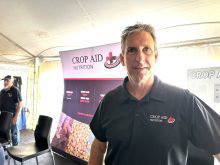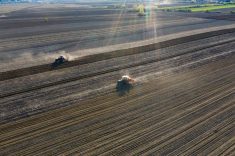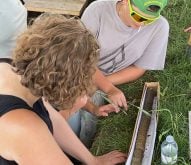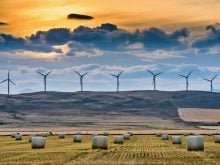Ask a dozen people for a definition of soil health and odds are you will get 12 different answers in response.
John Kolk is managing partner of Kolk Farms Conrich, located near Picture Butte, Alta., and is chair of the Alberta Biodiversity Monitoring Institute. He was also one of the speakers on a soil health panel hosted by Alberta Pulse Growers (APG) on Dec. 5, 2022.
In Kolk’s view, soil health comes down to what he can see or feel in the field. “For me, good soil health is you dig in there and you can smell it and you can taste it and you can see there’s something good in there,” he said. But Kolk conceded that can be a pretty hard sell to government officials, bankers and even agronomists.
Read Also

Claas brings 1000 Series SP forage harvesters to Canada
In mid-August, Claas unveiled its new line of Jaguar forage harvesters at an event in Visalia, California, deep in the heart of that state’s dairy region.
Scott Gillespie, a certified crop advisor who runs his own company, Plants Dig Soil Consulting, also participated in the seminar. He said for him, soil health comes down to buffering capacity and “whether your soil can buffer against pretty much anything you can think of.”
Gillespie also stressed good soil health doesn’t happen overnight. “In order to get a good, healthy soil or a good nutrient cycle going, there is a time of building and putting more into it before you start getting more out.”
Dirty roots
While there is considerable debate about what constitutes soil health, there is even more discussion about how to measure it.
Kolk said there might not be one definitive measure of soil health, but he knows it when he sees it. He shared a story about the time he was checking some cover crops last fall and pulled up a plant to examine its tillers.
“Ten years ago, when I pulled out roots like that in the fall, there would be nothing on the root — it would be just root. (Last fall) you could see how dirty it was. That to me is one measure of soil health that I can use on my farm,” Kolk said. “That dirty root … to me was probably the most exciting thing I’ve seen on my farm.”
Kevin Auch, who farms near Carmangay, Alta., shared a similar story during the seminar. He said 30 years ago much of the soil on his farm was the equivalent of beach sand. Auch then displayed a recent photo from his farm that showed a shovel full of soil with root forms and root structure and clumps of soil clearly sticking together, which he said illustrated how much his soil health-building efforts have paid off.
“That’s my measure of soil improvement. The carbon has gone up, the soil structure has improved. The water-holding capacity of that soil compared to the beach sand is just like night and day,” said Auch. “That’s why I do the stuff I do on my farm.”
So, what’s the best way to achieve healthy soil? Again, there is no one simple answer. That said, minimum tillage has become one of the most popular methods of soil conservation. Unlike intensive tillage, it does not require soil to be turned over and can significantly reduce labour and fuel costs, operator time and greenhouse gas emissions from cultivation. A growing number of new machines have been designed specifically for min-till farming.
Minimum tillage merits
Auch has been using minimum tillage on his farm for some time now, and he said it’s something of a no-brainer.
“If you figure a tillage operation can burn off up to an inch of moisture, if you save yourself a few tillage operations, that’s a couple of inches of moisture (you retain in the field). We used to have a saying that the difference between a good farmer and a bad farmer is an inch of rain. You’ve just created that inch of rain with that one good practice,” Auch said.

And the results speak for themselves, he added. “I started farming in the early ’80s, so we went through the ’80s droughts. Our crops these last couple of years compared to what they were (then), there were no comparisons,” Auch explained. “There was way higher production, and that’s all due to the soil being better. We’re saving the moisture and keeping the wind off the soil better.”
One of the forms of minimum tillage being adopted by a growing number of farms is strip tillage. It essentially combines the soil drying and warming benefits of conventional tillage with the soil-protecting elements of no till by disturbing only the portion of the soil that will contain the seed row.
Kolk began using strip tillage on his farm about four years ago. Not only has it helped to promote good soil health, Kolk said it has also resulted in considerable cost savings in terms of the amount of diesel fuel he requires during planting season. He said it has worked especially well when it comes to planting soybeans.
“Other than one quarter where it was too hard to cut the beans in, we are pretty happy overall with strip-tilling beans,” he said. “I’d love to be able to do it in the fall but we don’t always have the time to do that, and until you know where your seed canola goes, you don’t know where the rest of your crops go.”
Kolk cautioned there are some potential downsides to strip tillage. He said it can make weed control more problematic, for example.
Auch conceded he wasn’t initially a fan of minimum till and it took him some time to come around. He said farmers should keep an open mind about it.
“Be careful when you say never because I thought when I first saw no till … (the soil) is going to get as hard as a rock. That will never work,” Auch recalled. “Never say never. There may be practices you have to adopt that will make it work for you.”
Generating carbon (the main component of soil organic matter) is a huge part of building soil health as it gives soil its water-retention capacity. While there are a number of practices that can be used to achieve this, Gillespie said, it may take some time for equipment and other technologies to catch up.
Helping hand
Kolk said while he is an advocate for soil conservation, he wishes the government would provide more assistance to producers who incorporate it into their farming operations. He said while the federal government’s Agricultural Climate Solutions On-Farm Climate Action Fund helps farmers who adopt new technologies for this purpose, it does nothing for those who have been using them for years.
“I use my own seed and my own equipment, and I can’t apply for any of that because I’ve already been doing that (for years),” Kolk said.
Nevin Rosaasen, the sustainability and government relations lead for APG and moderator of the panel discussion, said that concern was raised at the recent GrowCanada Conference in Ottawa. He said there is a growing sentiment among farmers that those who adopted sustainable growing practices early on are being penalized while those who came to the table later are being rewarded.
“Why not reward the early adopters because they’re more likely to pursue new innovation and new practices that will get us even further,” Rosaasen said. “Governments are always trying not to pick winners and losers, but in this case, they are definitely penalizing those early adopters and rewarding the laggards.”
Gillespie said even though many soil conservation practices and technologies can pay for themselves, it often takes farmers years to realize a return on their investment and that could serve as a barrier for some to adopt them.
“When I’ve been looking at cover crops, it’s been hard to find a way to make them pay in at least a one- or two-year span,” he said.
Auch agreed. “The economic impediments are real. Drills are expensive and headers are expensive, so if you’re going to buy a stripper just for an experiment, that’s a pretty expensive experiment. It’s the same with a drill. It’s a big commitment. It’s like you are all in when you’re doing it, so you better sharpen up your pencil before you get started,” he said.
Soil health has been making headlines lately as a growing number of retailers and other buyers are making regenerative farm practices a condition of sale. That has led some to wonder how farmers are going to balance profitability and productivity with things like soil health.
Kolk said he isn’t too worried and suggested it’s not something other farmers should spend a lot of time worrying about either.
“Some of the criteria you’re seeing from these larger consumer companies probably aren’t going to be all that painful,” he said. “Those things don’t worry me too much because I think we’re already doing a lot of the stuff they’re asking us for.”















